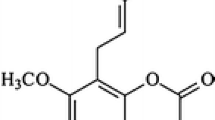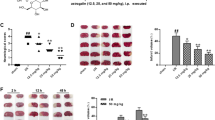Abstract
Stroke is an enormous public health problem with an imperative need for more effective therapy. Free radicals have been reported to play a role in the expansion of ischemic brain lesions, and the effect of free radical scavengers is still under debate. The present study investigated the neuroprotective effect of Ocimum sanctum (OS) to reduce brain injury after middle cerebral artery occlusion (MCAO). Male Wistar rats were subjected to MCAO for 2 h and reperfused for 22 h. The administration of OS (200 mg/kg bwt., orally) once daily for 15 days before MCAO showed marked reduction in infarct size, reduced the neurological deficits, and suppressed neuronal loss in MCAO rats. A significantly depleted activity of antioxidant enzymes and content of glutathione in MCAO group were protected significantly in MCAO group pretreated with OS. Conversely, the elevated level of thiobarbituric acid-reactive substances (TBARS) in MCAO group was attenuated significantly in OS-pretreated group when compared with MCAO group. Consequently, OS pretreatment may reduce the deterioration caused by free radicals, and thus may used to prevent subsequent behavioral, biochemical and histopathological changes that transpire during cerebral ischemia. This finding reflects that supplementation of OS intuitively by reasonable and understandable treatment effectively ameliorates the cerebral ischemia-induced oxidative damage.





Similar content being viewed by others
References
Das RR, Seshadri S, Beiser AS, Kelly-Hayes M, Au R, Himali JJ, Kase CS, Benjamin EJ, Polak JF, O’Donnell CJ, Yoshita M, D’Agostino RB, DeCarli C, Wolf PA (2008) Prevalance and correlates of silent cerebral infarcts in the framingham offspring study. Stroke 39:2929–2935
Sugawara T, Chan PH (2003) Reactive oxygen radicals and pathogenesis of neuronal death after cerebral ischemia. Antioxid Redox Signal 5:597–607
Kaushal V, Lyanne C (2008) Mechanisms of microglia-mediated neurotoxicity in a new model of the stroke penumbra. J Neurosci 28:2221–2230
Sardesai VM (1995) Role of antioxidants in health maintenance. Nutr Clin Pract 10:19–25
Faraci FM (2005) Oxidative stress: the curse that underlies cerebral vascular dysfunction. Stroke 36:186–188
Yousuf S, Salim S, Ahmad M, Ahmad AS, Ansari MA, Islam F (2005) Protective effect of khamira abresham uood mastagiwala against free radical induced damage in focal cerebral ischemia. J Ethnopharmacol 99:179–184
Khan MM, Ishrat T, Ahmad A, Hoda MN, Khan MB, Khuwaja G, Srivastava P, Raza SS, Islam F, Ahmad SS (2010) Sesamin attenuates behavioral, biochemical and histological alterations induced by reversible middle cerebral artery occlusion in the rats. Chem Biol Interact 183:255–263
Sharmila Banu G, Kumar G, Murugesan AG (2009) Effects of leaves extract of Ocimum sanctum L. on arsenic-induced toxicity in Wistar albino rats. Food Chem Toxicol 472:490–495
Sen P, Maiti PC, Puri S, Andulov NA, Valdman AV (1992) Mechanism of antistress activity of Ocimum sanctum linn, eugenol, tinospora malabarica in experimental animals. Indian J Exp Biol 30:592–596
Longa EZ, Weinstein PR, Carlson S, Cummins R (1989) Reversible middle cerebral artery occlusion without craniectomy in rats. Stroke 20:84–91
Yamamoto M, Tamura A, Kirino T, Shimizu M, Sano K (1988) Behavioural changes after focal cerebral ischemia by left middle cerebral artery occlusion in rats. Brain Res 452:323–328
Huang J, Philbert MA (1996) Cellular responses of cultured cerebellar astrocytes to ethacrynic acid-induced perturbation of subcellular glutathione homeostasis. Brain Res 711:184–192
Utley HC, Bernhein F, Hochslein P (1967) Effects of sulfhydryl reagent on peroxidation in microsomes. Arch Biochem Biophys 260:521–531
Islam F, Zia S, Sayeed I, Zafar KS, Ahmad AS (2002) Selenium induced alteration on lipids, lipid peroxidation, and thiol group in circadian rhythm centers of rat. Biol Trace Elem Res 90:1–12
Jollow DJ, Mitchell JR, Zampaghone N, Gillete JR (1974) Bromobenzene induced liver necrosis: protective role of glutathione and evidence for 3, 4-bromobenzene oxide as the hepatotoxic intermediate. Pharmacol 11:161–169
Carlberg I, Mannerviek B (1975) Glutathione reductase levels in rat brain. J Biol Chem 250:5475–5480
Mohandas J, Marshall JJ, Duggin GG, Horvath JS, Tiller D (1984) Differential distribution of glutathione and glutathione related enzymes in rabbit kidneys: Possible implication in analgesic neuropathy. Cancer Res 44:5086–5091
Habig WH, Pabst M, Jakoby WB (1986) Glutathione S-Transferase. The first enzymatic step in mercapturic acid formation. J Biol Chem 249:130–7139
Stevens MJ, Obrosova I, Cao X, Van Huysen CV, Greene DA (2000) Effect of DL-alpha-lipidic acid on peripheral nerve conduction, blood flow, energy metabolism and oxidative stress in experimental diabetic neuropathy. Diabetes 49:1006–1015
Claiborne A (1985) Catalase activity. In: Greenwald RA (ed) CRC hand book of methods for oxygen radical research. CRC, Boca Raton, pp 283–284
Nakayama H, Ginsberg MD, Dietrich WD (1988) (S)-Emopamil, 539 a novel calcium channel blocker and serotonin S2 antagonist, 540 markedly reduces infarct size following middle cerebral artery 541 occlusion in rat. Neurology 38:1667–1673
Lowry OH, Rosenbrough NJ, Farr AL, Randall RJ (1951) Protein measurement, with folin phenol reagent. J Biol Chem 193:265–275
Thiyagrajan M, Sharma S (2004) Neuroprotective effect of curcumin in middle cerebral artery occlusion induced focal cerebral ischemia. Life Sci 74:969–985
Hussain HEMA, Jamil K, Rao M (2001) Hypoglycaemic, Hypolipidemic and antioxidant properties of tulsi (Ocimum sanctum linn) on streptozotocin induced diabetes in rats. Indian J Clin Biochem 16:190–194
Schwarting RK, Steiner H, Huston JP (1991) Asymmetries in thigmotactic scanning: evidence for a role of dopaminergic mechanisms. Psychopharmacology 103:19–27
Blankenship D, Niemi J, Hilow E, Karl M, Sundararajan S (2011) Oral pioglitazone reduces infarction volume and improves neurologic function following MCAO in rats. Adv Exp Med Biol 915:157–162
Chan PH (2001) Reactive oxygen radicals in signaling and damage in the ischemic brain. J Cereb Blood Flow Metab 21:2–14
Candelario-Jalil E, Mhadu NH, Al-Dalain SM, Martínez G, León OS (2001) Time course of oxidative damage in different brain regions following transient cerebral ischemia in gerbils. Neurosci Res 41:233–241
Freeman BA, Crapo JD (1982) Biology of disease: free radicals and tissue injury. Lab Invest 47:412–426
Imam SZ, Ali SF (2000) Selenium, an antioxidant, attenuates methamphetamine-induced dopaminergic toxicity and peroxynitrite generation. Brain Res 855:186–191
Baez S, Segura-Aguilar J, Widersten M, Johansson AS, Mannervik B (1997) Glutathione transferases catalyse the detoxication of oxidized metabolite (o-quinones) of catecholamines and may serve as an antioxidant system preventing degenerative cellular processes. Biochem J 324:5–8
Acknowledgments
The authors are thankful to the Departments of Ayurveda, Yoga and Naturopathy, Unani, Siddha, and Homeopathy (AYUSH), Ministry of Health and Family Welfare, Government of India, New Delhi, for financial assistance. The authors wish to thank Mr. Dharamvir Singh for his assistance.
Author information
Authors and Affiliations
Corresponding author
Rights and permissions
About this article
Cite this article
Ahmad, A., Khan, M.M., Raza, S.S. et al. Ocimum sanctum attenuates oxidative damage and neurological deficits following focal cerebral ischemia/reperfusion injury in rats. Neurol Sci 33, 1239–1247 (2012). https://doi.org/10.1007/s10072-012-0940-1
Received:
Accepted:
Published:
Issue Date:
DOI: https://doi.org/10.1007/s10072-012-0940-1




